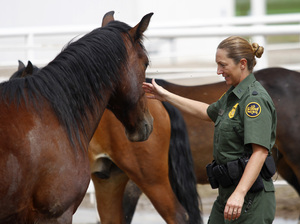The U.S. Border Patrol uses wild mustangs rounded up from the Rockies as it takes its hunt for smugglers into the most rugged terrain on the Arizona-Mexico border.
It's all new for Achilles: his name, his horseshoes, the surroundings at his home near Nogales, Ariz.
"To break 'em from what they're focusing on, you want to turn 'em from one side to the next," Border Patrol agent Luis Navarro says as he carefully leads Achilles into a round training arena.
Navarro holds the mustang by a short lead, and teaches it commands to trot and to slow down.
Just a few months ago, the 5-year-old horse was roaming the northern Nevada desert in a herd of wild mustangs. Then he was captured by the Bureau of Land Management in a roundup. First, he was sent to a Nevada prison, where inmates got him used to being around people. About a week ago, Achilles and three other mustangs arrived here.
Border Patrol supervisor Chris Dubois says the horses get trained to obey commands and learn to stay calm in the field.
"We're going to encounter groups of illegal aliens, narcotics smugglers, people hiking trails, you know, cars, trucks, water jugs — all types of things when we're out on the trails," he says.

Enlarge Joshua Lott/Reuters /Landov Border Patrol Agent Bobbi Schad pets a mustang at the agency's training facility in Willcox, Ariz., last August.
"We look for horses with big bones, big hooves, large legs, stout bodies," Dubois says. "That's kind of what we use here. I mean, if you could look around, it's all mountains where we're at. It's all ridge lines. It's all rough, rough, rough country."
Turns out the mustangs are actually better suited physically to the terrain than quarter horses. They're used to roaming harsh landscapes. The Border Patrol says no mustang has been injured on patrol since the program began.
But there's been a lot of criticism in the four decades they've been rounded up. The bureau says the land can't support some herds when they get too large. Mustang advocates say the horses are taken from their families and warehoused in feedlots.
But even critics like what the Border Patrol is doing.
"It utilizes the mustangs' brains and physical abilities, both of which are extensive, and it gives them a job, and it puts them in an environment in which they're very comfortable," says Ginger Kathrens, who heads the Cloud Foundation, a wild horse advocacy group. "I think it's challenging for them."
Achilles' trainer, Navarro, says the horse seems to be getting the hang of his new job.
"Just by the way he's reacting to the verbal commands, and the way he was paying attention to my hands and body language," he says. "I can see this horse will be ready in about a week or two."
Then, Achilles will patrol the border in southern Arizona for six or seven years before being retired or sold to the agent who's been riding him. In all, the Tucson Border Patrol sector has about 150 horses on patrol. Nearly half of them are now mustangs, and the agency expects the percentage to grow even more.










No comments:
Post a Comment